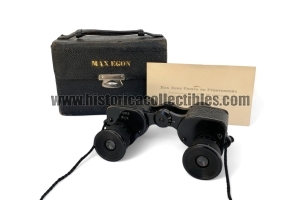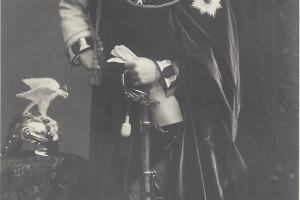Binoculars Chr. Beck&Sohne Cassel 3½x Fema, Max Egon Prince of Fürstenberg, circa 1920
Optical jewel, produced in a very limited number of examples, by "Chr. Beck & Sohne Cassel" and belonged to Maximilian Egon II, Prince of Fürstenberg (13 October 1863 – 11 August 1941). He was a German landowner, investor and nobleman who headed the House of Fürstenberg from 1896 to 1941.
These are very small opera binoculars, equipped with 3.5 magnifications, model called "Fema". Its dating is before 1928 as Cassel is written with a "C". In fact, it was only after 1928 that Cassel replaced the "C" with the "K" becoming Kassel.
In a period in which all the great giants of optical production produced large quantities of binoculars in series, albeit of excellent quality, "Chr. Beck & Sohne Cassel" became known for the production of very small batches of binoculars which were considered true and own jewels with perfect optical-mechanical characteristics and a unique design, as can be seen from the photos of this "Fema" model whose conformation of the binocular body is made with an accentuated "Heart" design.
This rare example is in excellent aesthetic and functional conditions: it comes complete with its original case equipped with a carrying strap and a mirror inside. Furthermore, in the back "pocket" there is the original business card of Prince Max Egon.
Max Egon
Born as Prince Maximilian Egon Christian Karl Aloys Emil Leo Richard Anton zu Fürstenberg, he was the son of Prince Maximilian Egon zu Fürstenberg and his wife, Countess Leontina von Khevenhüller-Metsch. He had a younger brother, born in 1867, named Prince Karl Emil Egon zu FürstenbergA close friend and adviser of Emperor Wilhelm II of Germany, Max of Fürstenberg inherited territorial titles in Prussia, Austria, Hungary, Württemberg and Baden, and by virtue of them had a seat in the House of Lords in each of the five states. Until the First World War, he was vice-president of the Prussian House of Lords.
His principal residence was the Princely Palace in Donaueschingen, near the source of the Danube, where he owned large deer forests. Emperor Wilhelm II frequently visited him there, and Max invariably accompanied the Emperor on his hunting expeditions and Norwegian trips. As well as his vast ancestral forests, he also owned coal mines, hotels and breweries.
Although he was a member of the high Roman Catholic Uradel who had long stood aloof from party politics, after meeting Adolf Hitler and Ernst Roehm in November 1933, Max became enthusiastic about Hitler's leadership, commenting that "It was wonderful, to be able to meet such a great man".
The same year, 1933, he joined the Nazi Party and the SA. In 1938, he was appointed to the rank of Standartenführer.





